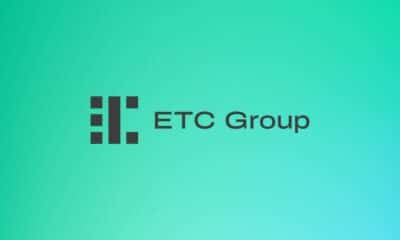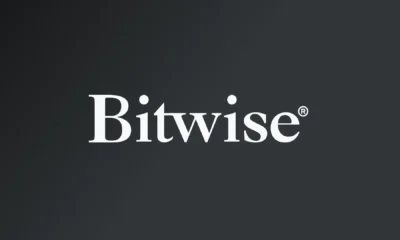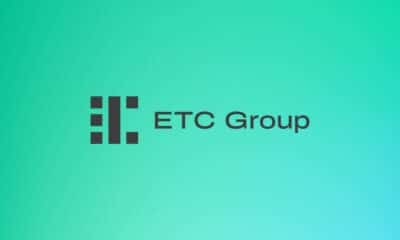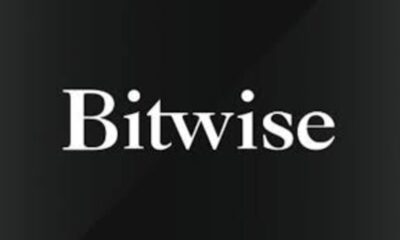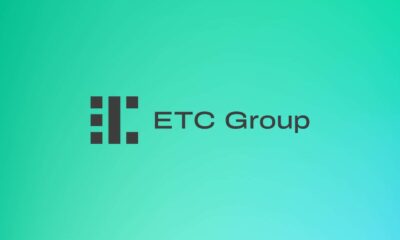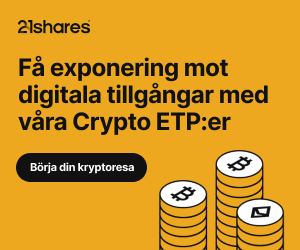Nyheter
Successfully navigate through Bitcoin & Cryptoassets Markets
Publicerad
1 år sedanden

• Cryptoassets rebound from losses sparked by geopolitical tensions amid Bitcoin Halving
• Our in-house “Cryptoasset Sentiment Indicator” has also rebounded from year-to-date lows
• Bitcoin Halving: In the past, most of the positive performance accrued after the Halving event
Chart of the Week
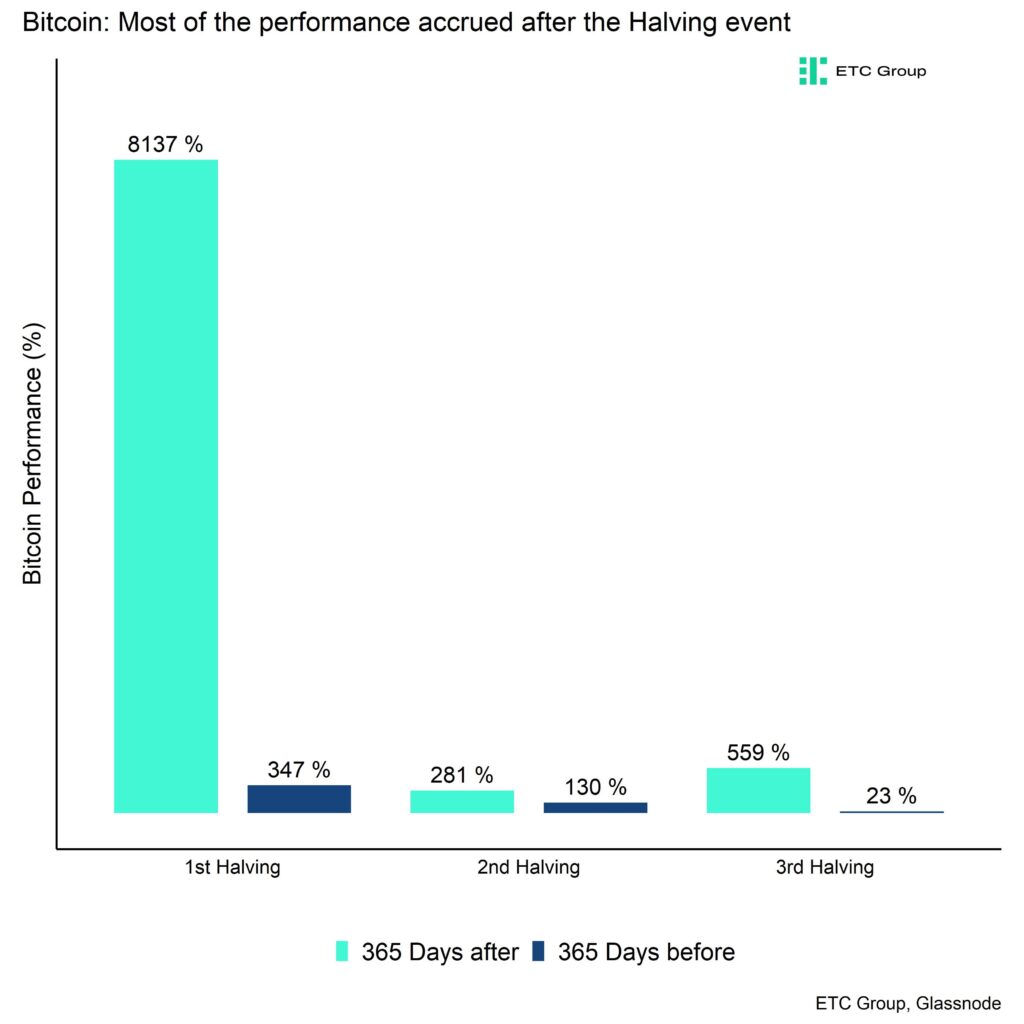
Performance
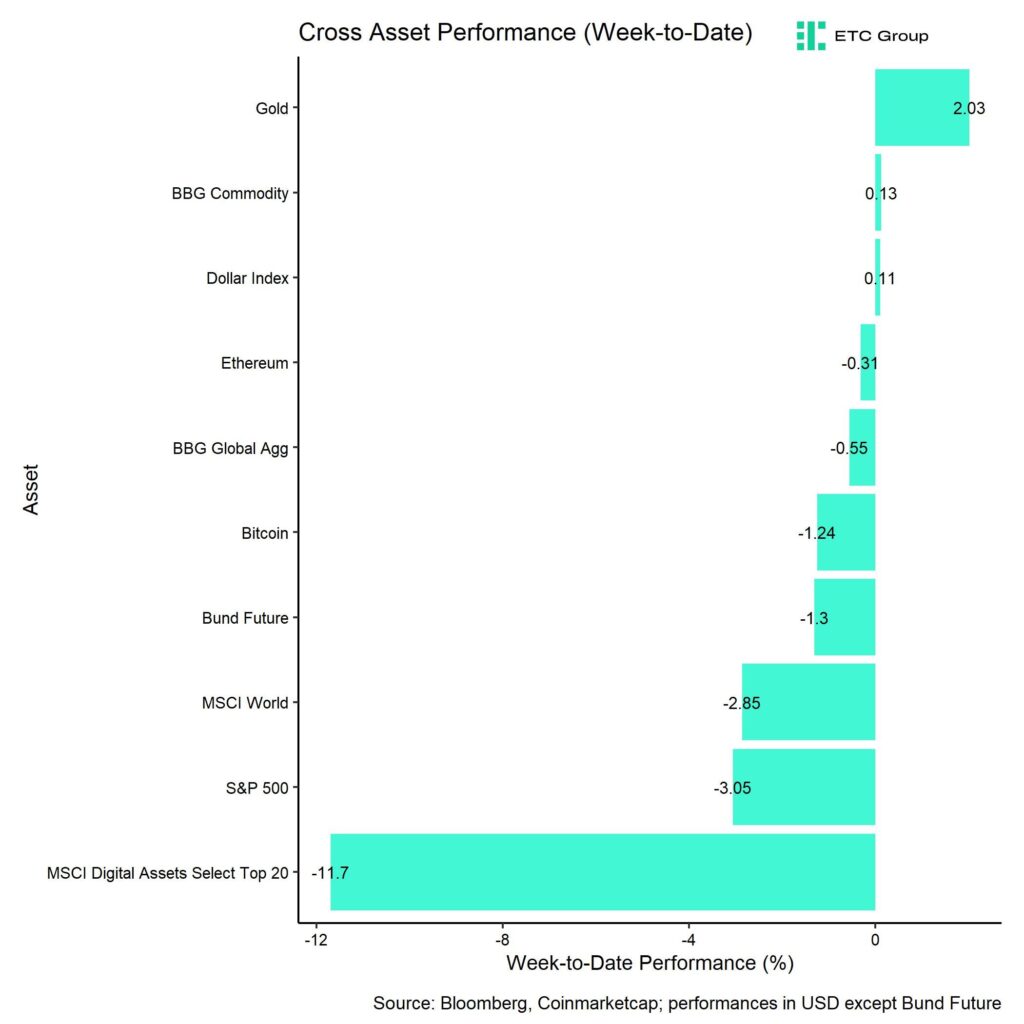
Last week, cryptoassets came under pressure on account of rising geopolitical risks in the Middle East that led to a general decline in risky assets across the board.
However, most major cryptoassets have already retraced most of these losses amid the highly anticipated Bitcoin Halving that has halved the block subsidy from 6.25 BTC per block to 3.125 BTC. The fourth Bitcoin Halving has occurred on the 20th April at 02:09:27 UTC.
We think that the positive performance effect of the Halving is not priced in and expect this effect to unfold after around 100 days after this event, i.e. around July 2024 onwards. The reason is that the supply deficit induced by the Bitcoin Halving only tends to accumulate over time and is rather insignificant in the very short term.
In general, it is important to note that most of the Halving related performance tends to accrue after Halving event dates which implies that Halving events have not been “front-run” by investors in the past. Besides, the performance differences post- and pre-Halving were so significant that the Halving effect is unlikely to be pure coincidence. Read more in our deep dive into the Bitcoin Halving here.
Along with the latest Halving, we saw a significant spike in transaction fees in the Bitcoin core network which has sparked renewed discussions around the viability of Bitcoin as a means-of-exchange. In fact, we saw a record-high in daily revenue for Bitcoin miners just yesterday of around 107 mn USD of which around 80 mn USD came from transaction fees alone.
The introduction of Runes, a new protocol that enables users to ”etch” and mint tokens on the Bitcoin blockchain, may be the cause of the fee increase. Speculators flocked to create tokens and trade meme coins as soon as Runes launched, which accelerated transaction volume and raised transaction fees.
At the time of writing, there were 3,700 Runes inscriptions total on the Bitcoin blockchain, according to data source Ord.io.
We think that these increases in transaction fees will only accelerate the usage of more cost-effective Bitcoin Layer 2 solutions like the Lightning Network and or no material risk to Bitcoin. To the contrary, the increase in transactions fees as a percentage of the overall block reward should continue to incentivize Bitcoin miners to secure the network amid decreasing block subsidies going forward.
Meanwhile, Ethereum managed to outperform Bitcoin amid the stalling bull market rallye along with a general rotation into altcoins.
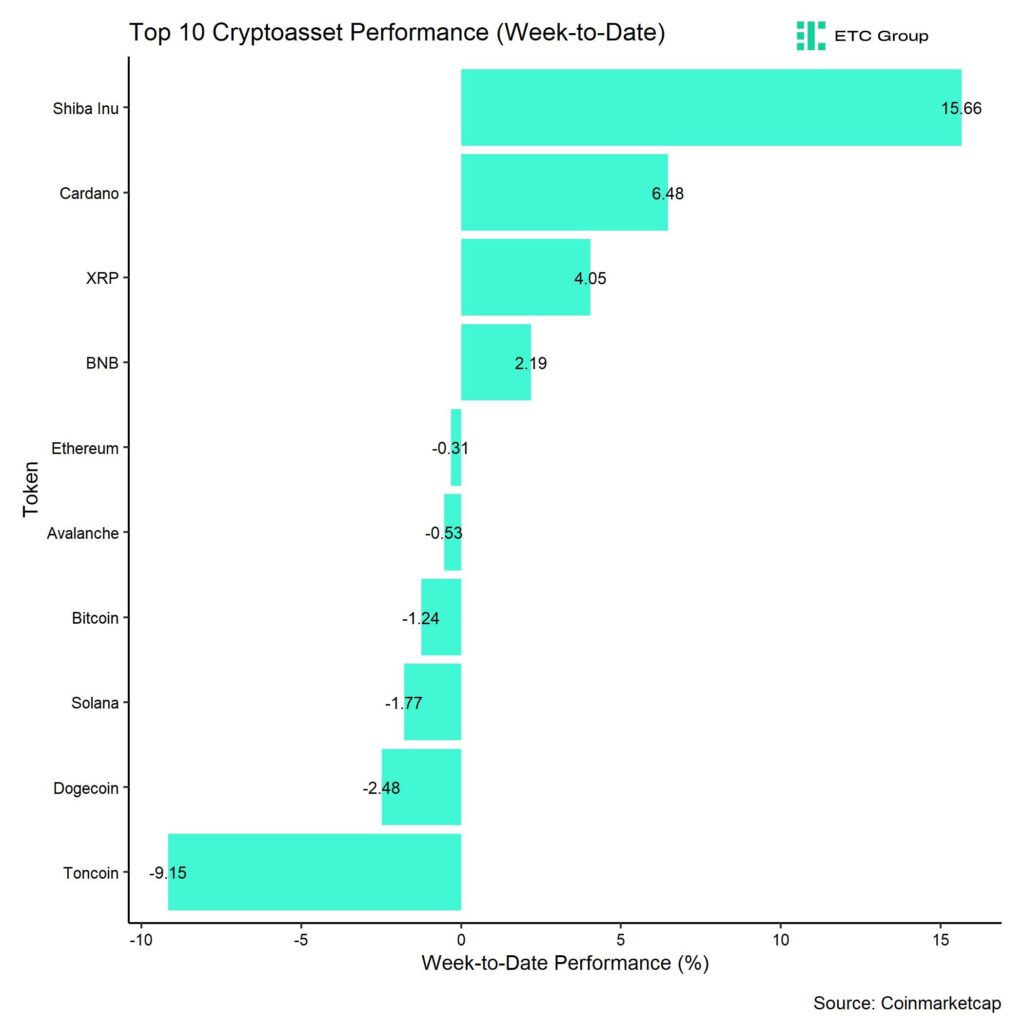
In general, among the top 10 crypto assets, Shiba Inu, Cardano, and XRP were the relative outperformers.
Overall altcoin outperformance vis-à-vis Bitcoin also picked up compared to the week prior, with around 65% of our tracked altcoins managing to outperform Bitcoin on a weekly basis.
Sentiment
Our in-house “Cryptoasset Sentiment Index” has rebounded from year-to-date lows that were induced by the rise in geopolitical tensions. The index is currently still signalling bearish sentiment.
At the moment, only 2 out of 15 indicators are above their short-term trend.
Based on the significant reduction in sentiment, we think that a short-term stabilization is very likely.
Last week, there were significant reversals to the downside in the global crypto hedge fund beta and BTC long futures liquidation dominance.
The Crypto Fear & Greed Index remains in ”Greed” territory as of this morning.
Besides, our own measure of Cross Asset Risk Appetite (CARA) has also decreased throughout the week which signals increased bearish sentiment in traditional financial markets.
Performance dispersion among cryptoassets has increased amid the recent correction. Overall performance dispersion still remains slightly elevated.
In general, high performance dispersion among cryptoassets implies that correlations among cryptoassets are low, which means that cryptoassets are trading more on coin-specific factors and that cryptoassets are increasingly decoupling from the performance of Bitcoin.
This is also consistent with the fact that altcoin outperformance vis-à-vis Bitcoin has recently picked up compared to the week prior, with around 65% of our tracked altcoins that have outperformed Bitcoin on a weekly basis. At the same time, there was a slight outperformance of Ethereum vis-à-vis Bitcoin last week.
In general, increasing altcoin outperformance tends to be a sign of increasing risk appetite within cryptoasset markets.
Fund Flows
Last week, we saw a pick-up in overall crypto ETP redemptions and net outflows amid a broad risk-off environment of around -239.7 mn USD (week ending Friday) based on Bloomberg data.
Global Bitcoin ETPs dominated with net outflows of -203.4 mn USD of which -204.6 mn (net) were related to US spot Bitcoin ETFs alone. The ETC Group Physical Bitcoin ETP (BTCE) also saw net outflows equivalent to -34.4 mn USD last week.
The Grayscale Bitcoin Trust (GBTC) continued to experience high net outflows of approximately -458.4 mn USD last week. However, other US spot Bitcoin ETFs even managed to attract +254 mn USD (ex GBTC).
Global Ethereum ETPs also saw significant net outflows last week of around -67.7 mn USD. Meanwhile, the ETC Group Physical Ethereum ETP (ZETH) had neither creations nor redemptions (+/- 0 mn USD). The same is true for the ETC Group Ethereum Staking ETP (ET32) last week.
Besides, Altcoin ETPs ex Ethereum again managed to attract net inflows of around +19.3 mn USD amid the rotation into altcoins last week.
Besides, Thematic & basket crypto ETPs also experienced net inflows of +11.9 mn USD, based on our calculations. The ETC Group MSCI Digital Assets Select 20 ETP (DA20) also experienced net inflows of around +0.8 mn USD last week.
Besides, the beta of global crypto hedge funds to Bitcoin over the last 20 trading decreased significantly to around 0.64 which implies that global crypto hedge funds have significantly reduced their market exposure and are significantly underweight relative to the market.
On-Chain Data
Despite the recent sell-off towards 60k USD in Bitcoin, coins continue to be taken off exchanges on a net basis as BTC exchange balances have recently reached a new multiyear low. Likewise, Ethereum has seen a continued drawdown in exchange balances which should provide a tailwind for the smart contract platform.
That being said, the latest sell-off saw an increase in net BTC transfers to exchanges by larger wallet sizes (>10 mn USD) which is usually a bearish signal.
This is also corroborated by positive net BTC exchange inflows from whales (entities that control at least 1,000 BTC) over the past week.
Overall net buying volumes for Bitcoin have been negative over the past week as evidenced by negative cumulative volume delta (CVD) on exchanges. The cumulative volume delta (CVD), which measures the net difference between buying and selling trade volumes, was negative with around -261 mn USD in net selling volumes over the past week.
Continuing negative US spot Bitcoin ETF fund flows were certainly a major driver of this selling volume.
In our latest report at the end of March, we wrote:
“Ongoing consolidation appears to be relatively likely in the short term despite the upcoming Bitcoin Halving in April. The reason is that the positive effects from the Halving only become visible around 100 days after the Halving according to our latest analyses.
If the market was trading lower, we should find support in Bitcoin near 55.4k USD as the short-term holder’s cost basis is around that price level. Short-term holders tended to capitulate whenever the price dipped below their cost basis which should provide a solid basis for a continuation of the bull market.”
We still expect this to be our base case although the significant decrease in Cryptoasset Sentiment Index has made a short-term stabilization very likely.
The spike in inscriptions induced network activity and fees in the Bitcoin network could also be a headwind in the short-term as active addresses have plunged to year-to-date lows recently.
This implies that high transaction fees are somewhat leading to lower usage of the Bitcoin network as users might be waiting for lower fess. Transaction fess are already becoming increasingly prohibitive for some users.
Futures, Options & Perpetuals
Last week, there was a general decline in both Bitcoin futures and perpetual open interest due to increased liquidations and a general de-risking in positioning.
Bitcoin futures open interest on CME also continued to decrease. Since the peak in open interest on the 20th of March, open interest in Bitcoin CME futures has already declined by -29k BTC.
Consistent with this development the Bitcoin futures basis also continued to decline. At the time of writing, the 3-months annualized Bitcoin futures basis rate is at around 10.0% p.a. which marks a significant decline from the highs observed at the end of March (~30.4% p.a.).
The Bitcoin perpetual funding rate also declined significantly and also went negative on Thursday last week.
In contrast, Bitcoin options’ open interest even increased slightly last week. The Put-call open interest went sideways last week. There was also no significant spike in relative trading volumes between puts and calls that you would normally expect during a sell-off like last week.
That being said, the 25-delta BTC 1-month option skew increased significantly as BTC options traders paid significantly higher volatility premia for puts than for delta-equivalent calls. Skews have normalized a bit more recently though.
Meanwhile, BTC option implied volatilities remained relatively elevated. Implied volatilities of 1-month ATM Bitcoin options are currently at around 69.7% p.a.
Bottom Line
• Cryptoassets rebound from losses sparked by geopolitical tensions amid Bitcoin Halving
• Our in-house “Cryptoasset Sentiment Indicator” has also rebounded from year-to-date lows
• Bitcoin Halving: In the past, most of the positive performance accrued after the Halving event
To read our Crypto Market Compass in full, please click the button below:

Disclaimer
Important Information
The information provided in this material is for informative purposes only and does not constitute investment advice, a recommendation or solicitation to conclude a transaction. This document (which may be in the form of a blogpost, research article, marketing brochure, press release, social media post, blog post, broadcast communication or similar instrument – we refer to this category of communications generally as a “document” for purposes of this disclaimer) is issued by ETC Issuance GmbH (the “issuer”), a limited company incorporated under the laws of Germany, having its corporate domicile in Germany. This document has been prepared in accordance with applicable laws and regulations (including those relating to financial promotions). If you are considering investing in any securities issued by ETC Group, including any securities described in this document, you should check with your broker or bank that securities issued by ETC Group are available in your jurisdiction and suitable for your investment profile.
Exchange-traded commodities/cryptocurrencies, or ETPs, are a highly volatile asset and performance is unpredictable. Past performance is not a reliable indicator of future performance. The market price of ETPs will vary and they do not offer a fixed income. The value of any investment in ETPs may be affected by exchange rate and underlying price movements. This document may contain forward-looking statements including statements regarding ETC Group’s belief or current expectations with regards to the performance of certain asset classes. Forward-looking statements are subject to certain risks, uncertainties and assumptions, and there can be no assurance that such statements will be accurate and actual results could differ materially. Therefore, you must not place undue reliance on forward-looking statements. This document does not constitute investment advice nor an offer for sale nor a solicitation of an offer to buy any product or make any investment. An investment in an ETC that is linked to cryptocurrency, such as those offered by ETC Group, is dependent on the performance of the underlying cryptocurrency, less costs, but it is not expected to match that performance precisely. ETPs involve numerous risks including, among others, general market risks relating to underlying adverse price movements and currency, liquidity, operational, legal, and regulatory risks.
Du kanske gillar
Nyheter
From digital asset to safe haven: Why is Bitcoin acting like gold?
Publicerad
15 timmar sedanden
28 april, 2025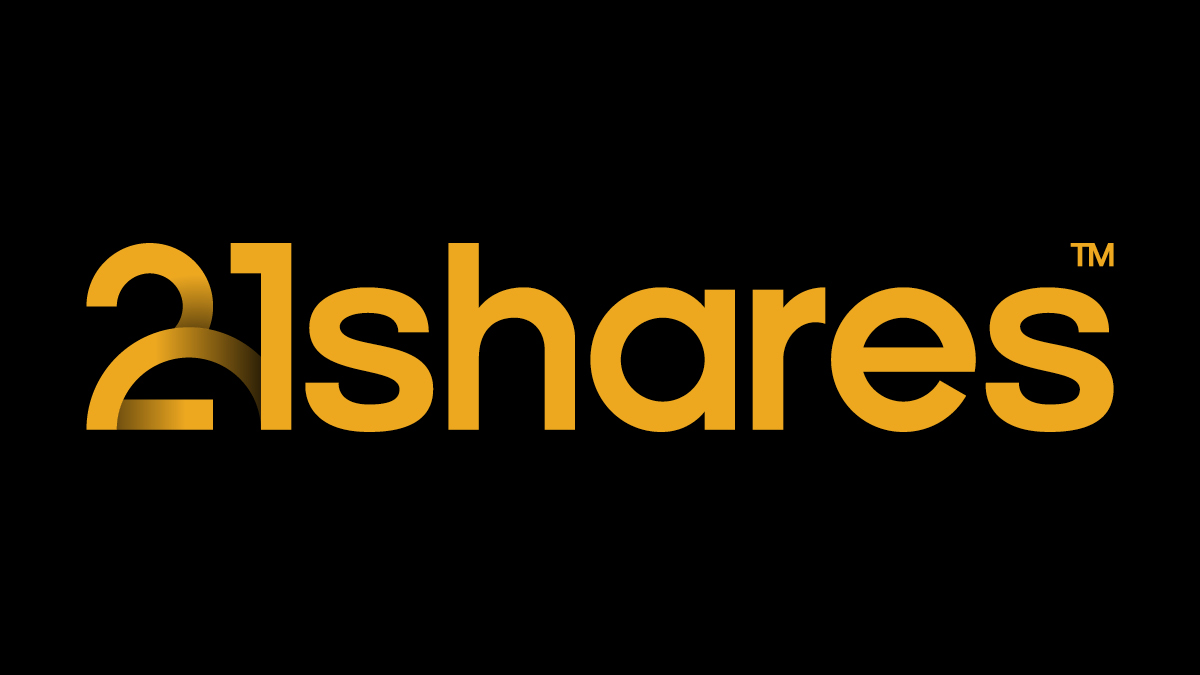
Bitcoin’s price has taken a different path from U.S. stocks over the past weeks. While major indexes such as the S&P 500 and Nasdaq have experienced declines, Bitcoin has risen to its highest levels in recent months, positioning itself as a safe haven, similar to gold. Understand how Bitcoin and gold have been synced for some time and what the correlation might look like in the future.
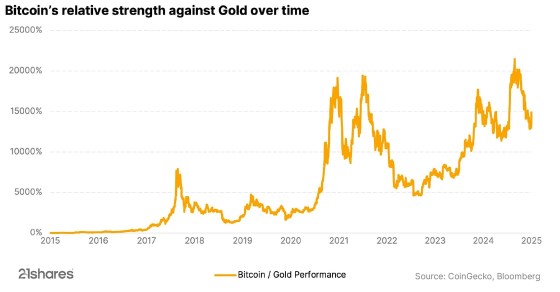

Ethereum’s big reboot: Why investors should be excited
Ethereum is making headlines due to a potential change in its core software, the Ethereum Virtual Machine (EVM), that operates across thousands of computers, enabling Ethereum to execute smart contracts and securely track transactions. However, Ethereum’s co-founder, Vitalik Buterin, has suggested replacing the EVM with a new system called RISC-V. Discover why the change is necessary and its potential impact on investors.
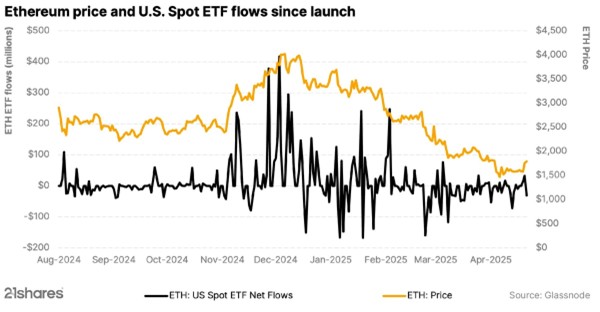


Thousands of altcoins, but no altcoin season: What comes next?
Over the past year, the crypto market has entered a new era. Bitcoin hit new all-time highs, outperforming other cryptocurrencies and decoupling from the stock market. Unlike previous cycles, the expected “altcoin season” did not occur, with Bitcoin remaining strong and money not flowing into other cryptocurrencies or altcoins. So, the big question is: Has altcoin season run its course?
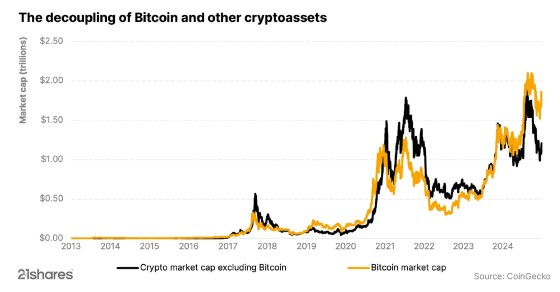

Research Newsletter
Each week the 21Shares Research team will publish our data-driven insights into the crypto asset world through this newsletter. Please direct any comments, questions, and words of feedback to research@21shares.com
Disclaimer
The information provided does not constitute a prospectus or other offering material and does not contain or constitute an offer to sell or a solicitation of any offer to buy securities in any jurisdiction. Some of the information published herein may contain forward-looking statements. Readers are cautioned that any such forward-looking statements are not guarantees of future performance and involve risks and uncertainties and that actual results may differ materially from those in the forward-looking statements as a result of various factors. The information contained herein may not be considered as economic, legal, tax or other advice and users are cautioned to base investment decisions or other decisions solely on the content hereof.
Nyheter
WELC ETF ger exponering mot företag inom sällanköpsvaror
Publicerad
16 timmar sedanden
28 april, 2025
Amundi S&P Global Consumer Discretionary ESG UCITS ETF DR EUR (D) (WELC ETF) med ISIN IE00061J0RC6, strävar efter att spåra S&P Developed Ex-Korea LargeMidCap Sustainability Enhanced Consumer Discretionary index. Det S&P-utvecklade ex-Korea LargeMidCap Sustainability Enhanced Consumer Discretionary-indexet spårar stora och medelstora företag från den diskretionära konsumentsektorn. ESG-kriterier (miljö, social och bolagsstyrning) beaktas vid valet av värdepapper.
Den börshandlade fondens TER (total cost ratio) uppgår till 0,18% p.a.. Amundi S&P Global Consumer Discretionary ESG UCITS ETF DR EUR (D) är den billigaste ETF som följer S&P Developed Ex-Korea LargeMidCap Sustainability Enhanced Consumer Discretionary index. ETFen replikerar det underliggande indexets prestanda genom fullständig replikering (köper alla indexbeståndsdelar). Utdelningarna i ETFen delas ut till investerarna (Årligen).
Amundi S&P Global Consumer Discretionary ESG UCITS ETF DR EUR (D) är en mycket liten ETF med 5 miljoner euro förvaltade tillgångar. Denna ETF lanserades den 20 september 2022 och har sin hemvist i Irland.
Investeringsmål
AMUNDI S&P GLOBAL CONSUMER DISCRETIONARY ESG UCITS ETF DR – EUR (D) försöker replikera, så nära som möjligt, resultatet för S&P Developed Ex-Korea LargeMidCap Sustainability Enhanced Consumer Discretionary Index (Netto Total Return Index). Denna ETF har exponering mot stora och medelstora företag i utvecklade länder. Den innehåller uteslutningskriterier för tobak, kontroversiella vapen, civila och militära handeldvapen, termiskt kol, olja och gas (inkl. Arctic Oil & Gas), oljesand, skiffergas. Den är också utformad för att välja ut och omvikta företag för att tillsammans förbättra hållbarhet och ESG-profiler, uppfylla miljömål och minska koldioxidavtrycket.
Handla WELC ETF
Amundi S&P Global Consumer Discretionary ESG UCITS ETF DR EUR (D) (WELC ETF) är en europeisk börshandlad fond. Denna fond handlas på flera olika börser, till exempel Deutsche Boerse Xetra.
Det betyder att det går att handla andelar i denna ETF genom de flesta svenska banker och Internetmäklare, till exempel Nordnet, SAVR, DEGIRO och Avanza.
Börsnoteringar
Största innehav
Denna fond använder fysisk replikering för att spåra indexets prestanda.
| Namn | Valuta | Vikt % | Sektor |
| AMAZON.COM INC | USD | 18.89 % | Sällanköpsvaror |
| TESLA INC | USD | 13.29 % | Sällanköpsvaror |
| HOME DEPOT INC | USD | 5.75 % | Sällanköpsvaror |
| LVMH MOET HENNESSY LOUIS VUI | EUR | 5.44 % | Sällanköpsvaror |
| TOYOTA MOTOR CORP | JPY | 4.58 % | Sällanköpsvaror |
| MCDONALD S CORP COM NPV | USD | 2.63 % | Sällanköpsvaror |
| LOWE S COS INC COM US 0.50 | USD | 2.38 % | Sällanköpsvaror |
| SONY GROUP CORP (JT) | JPY | 2.25 % | Sällanköpsvaror |
| BOOKING HOLDINGS INC | USD | 2.02 % | Sällanköpsvaror |
| TJX COMPANIES INC | USD | 1.89 % | Sällanköpsvaror |
Innehav kan komma att förändras
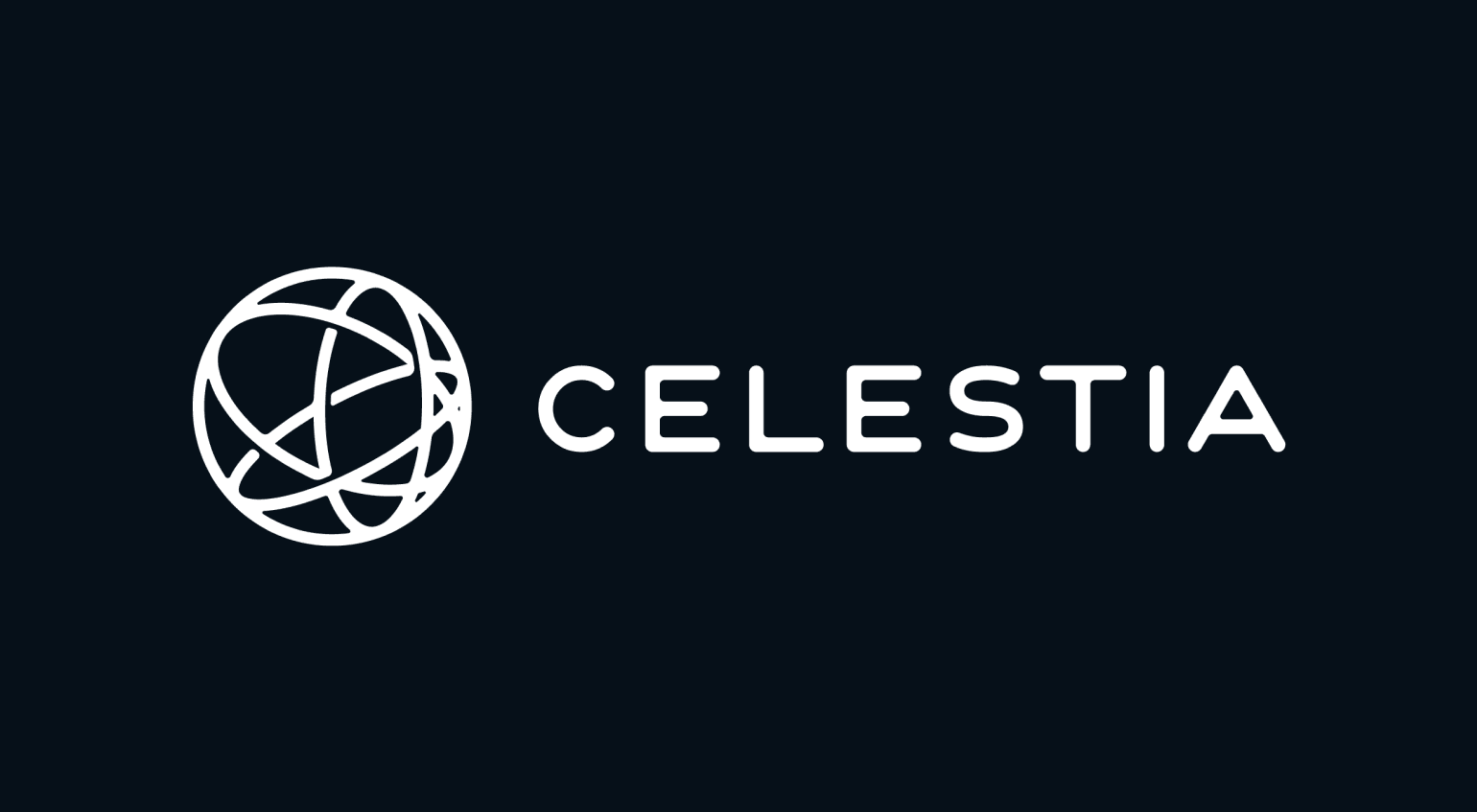
To understand Celestia’s value and its role in the ecosystem, it’s helpful to first understand how traditional blockchain systems are structured.
Most blockchains, like Ethereum or Bitcoin, are monolithic which means they perform all major functions (consensus, data availability, and execution) on a single layer. This design ensures security but according to new modular networks, limits scalability and flexibility.
The modular blockchain thesis, which Celestia is leading, proposes separation of layers and respective responsibilities in the network. Instead of having one network and its validators perform all of its functions, it may be better to have specialized layers:
• Consensus Layer: Ensures that all nodes agree on the order of transactions.
• Data Availability Layer: Ensures transaction data is accessible to all participants.
• Execution Layer: Processes the actual logic and computation of smart contracts.
By unbundling these components, developers can build more efficient, flexible systems that scale far beyond what monolithic blockchains can support. Not all applications need similar levels of security and not all applications need to scale up to millions of transactions. Additionally, one application might be scaling beyond the capabilities of its host network, severely effecting the available data throughput of other applications. This limits developers to the monolithic technology stack provided by a virtual machine such as Ethereum’ EVM.
The Issue of Data Availability
One of the most misunderstood yet crucial components of any blockchain is data availability. In simple terms, it ensures that the data behind each block is fully accessible and verifiable by all participants in the network. Another way to describe it is as the confidence a user can have that the data required to verify a block is really available to all network participants. Data availability is therefore important to all stakeholders of the blockchain ecosystem.
If a block producer withholds data, then nodes cannot verify the block, which leads to potential censorship or fraud.
Traditionally, a blockchain network can offer data availability with the following mechanisms:
• Full Replication: Every node stores the entire blockchain and verifies all data. Secure but not quite scalable.
• Sharding: Breaks the blockchain into smaller pieces (shards), spreading data across nodes. Scalable but highly complex to implement.
• Committee-Based Models: Small groups of nodes are trusted to verify data availability. Efficient, but less decentralized.
Celestia takes a completely different approach using a novel method called Data Availability Sampling (DAS). Instead of requiring every node to download all data, DAS allows lightweight nodes to randomly sample small chunks of a block. If enough pieces are retrievable, the node can confidently assume the full block is available. This slashes resource requirements while maintaining security and decentralization.
Why Data Availability Matters
Data availability might sound like a nerdy technical term, but it’s one of the most important yet one of less invisible parts of how blockchains work.
Let’s say you’re using a crypto app to trade tokens, store art, or move money. Every time you do something, that action (also referred to as a transaction) needs to be recorded and shared with the rest of the network so everyone agrees it happened. If that data disappears or can’t be verified, the whole system becomes untrustworthy. You might think your tokens moved but if no one else can see that record or a different version of that record, it’s as if it never happened.
Here’s a real-life parallel: imagine a public scoreboard at a sports game. If the scorekeeper shows the score to only a few people and then hides the board, how can the rest of the crowd trust the result? Everyone needs to see the score to believe it’s fair. In crypto, data availability is what makes sure the scoreboard is always visible to all participants at any time.
How DAS Changes the Game
Traditionally, ensuring data availability meant every node had to download and verify the entire block of data for any purpose related to particular data inside the block, like reading a whole newspaper just to check one article. Ethereum and most competing monolithic layer-1’s operate this way. It works, but it’s expensive, slow, and becomes less practical as blockchains scale in terms of data throughput required by its Dapps therefore limiting the types of applications that developers can build.
Celestia’s Data Availability Sampling (DAS) is a breakthrough that lets even simple devices (like smartphones) verify that a block’s data is available—by checking just a few random pieces. If enough pieces are found and correct, the network can be confident the full block is truly there and correct.
This innovation means:
• Light clients can safely participate in the network without downloading everything.
• Rollups and app-chains can post their data to Celestia with minimal overhead.
• Scalability skyrockets without sacrificing decentralization.
Celestia’s Role in Scaling Applications
Celestia is the first blockchain designed specifically to be a modular data availability layer. That means it doesn’t execute smart contracts or handle transactions directly, instead, it provides a foundation for others to build new networks, also referred to as rollups.
Developers can launch rollups or full execution environments, and use Celestia to handle the consensus and data availability side. This unlocks several key benefits:
• Massive scalability: Apps can scale independently from each other.
• Customization: Developers choose their own virtual machines, consensus mechanism and execution logic.
• Decentralization: Thanks to DAS, even small devices can validate the system.
This approach flips the script on how we think about launching and scaling blockchains. Instead of competing for space on a monolithic chain, apps get their own chains, backed by Celestia’s secure and scalable data availability layer while giving developers full stack control over their applications.
Celestia Enables Scalability and Offers Full-Stack Control
Using the restaurant example from Sui vs Aptos. Imagine a big, busy restaurant where the chefs, waiters, and cashiers all work in the same small kitchen. It gets crowded, orders take forever, and sometimes things go wrong while the backlog of orders keeps growing. That’s how traditional blockchains work, doing everything in one place.
Now imagine if the restaurant separated the jobs: the chefs cook in a big kitchen, waiters serve from a clean dining area, and the cashiers handle payments at the front desk. Everything runs smoother, faster, and the restaurant can grow in a environment that is less prone to congestion. That is what Celestia is doing for blockchains. Let’s say a small specialty restaurant opens up next door, leveraging Celestia’s register and order management system. That new restaurant can fully focus on delivering the best food and experience to customers, knowing that Celestia’s technology won’t be the limiting factor when scaling up their kitchen. The modularity that Celestia’s restaurant offers is allowing a lot of small scale restaurants to exist without the overhead of individual administrative work. It goes even a step further, Celestia allows you to just use it register while letting smaller restaurants pick their own kitchen (execution environment) and order management system (consensus layer).
In conclusion, Celestia is challenging the believe that blockchains should always be monolithic and blockchains need to offer the same technology stack to all developers on its chain. It is a significant leap forward in the crypto ecosystem and opens possibilities that were previously not feasible.
Diversify Crypto Exposure to Modular Blockchain Technology with the VanEck Celestia ETN
Key features of the VanEck Celestia ETN
• Celestia enables secure scaling of blockchain applications with modular technology.
• Fully-collateralized by TIA in cold-storage.
• Total return of TIA: Tracks the MarketVector™ Celestia VWAP Close Index (MVTIAV).
Why VanEck Crypto ETNs? Here’s why:
• With nearly 70 years in asset management and a strong track record in crypto, we bring deep industry knowledge and proven reliability.
• We combine traditional financial strengths with cutting-edge crypto innovation, backed by a CEO who truly believes in crypto’s future.
• We ensure clarity in our product structures and avoid high-risk or opaque practices, with assets fully backed by cryptocurrency in secure cold storage.
• Our assets are secured by a licensed European bank in Liechtenstein, providing top-tier compliance and security.
• We use the safest institutional custody setup available, prioritizing your security over cost savings.
Crypto is an asset class with high potential returns but investing in digital assets comes with great risk, why choose products that potentially introduce even more risks? Choose VanEck for a secure, transparent, and expertly managed crypto investment experience.
Main Risk Factors:
Investors should note that there is no direct ownership for the crypto assets, but a claim against Issuer to receive such assets.
• Complexity risk: The complexity of the project and its technological concepts make it challenging to assess its viability and valuation.
• Adoption risk: Celestia introduces additional adoption risk as it is uncertain if the concept of modular blockchains will succeed.
• Technology risk: Celestia introduces additional technology risk due to the technology being less mature and therefore could be more prone to bugs and exploits.
• Regulatory Risk: market disruptions and governmental interventions may make digital assets illegal.
• Risk of Losses and Volatility: The trading prices of many digital assets have experienced extreme volatility in recent periods and may continue to do so. There is a risk of total loss as no guarantee can be made regarding custody due to hacking risk, counterparty risk and market risk.
• Other risks specific to this ETN’s Digital Assets can also be found on the VanEck Crypto Academy.
This is not financial research but the opinion of the author of the article. We publish this information to inform and educate about recent market developments and technological updates, not to give any recommendation for certain products or projects. The selection of articles should therefore not be understood as financial advice or recommendation for any specific product and/or digital asset. We may occasionally include analysis of past market, network performance expectations and/or on-chain performance. Historical performance is not indicative for future returns.
IMPORTANT INFORMATION
For informational and advertising purposes only.
This information originates from VanEck (Europe) GmbH, Kreuznacher Strasse 30, 60486 Frankfurt am Main, Deutschland and VanEck Switzerland AG, Genferstrasse 21, 8002 Zurich, Switzerland.
It is intended only to provide general and preliminary information to investors and shall not be construed as investment, legal or tax advice. VanEck (Europe) GmbH and its associated and affiliated companies (together “VanEck”) assume no liability with regards to any investment, divestment or retention decision taken by the investor on the basis of this information. Views and opinions expressed are current as of the date of this information and are subject to change with market conditions. Certain statements contained herein may constitute projections, forecasts and other forward looking statements, which do not reflect actual results. VanEck makes no representation or warranty, express or implied regarding the advisability of investing in securities or digital assets generally or in the product mentioned in this information (the “Product”) or the ability of the underlying Index to track the performance of the relevant digital assets market.
Investing is subject to risk, including the possible loss of principal up to the entire invested amount and the extreme volatility that ETNs experience. You must read the prospectus and KID before investing, in order to fully understand the potential risks and rewards associated with the decision to invest in the Product. The approved Prospectus is available at www.vaneck.com. Please note that the approval of the prospectus should not be understood as an endorsement of the Products offered or admitted to trading on a regulated market.
The underlying Index is the exclusive property of MarketVector GmbH, which has contracted with CC Data Limited to maintain and calculate the Index. CC Data Limited uses its best efforts to ensure that the Index is calculated correctly. Irrespective of its obligations towards the MarketVector GmbH, CC Data Limited has no obligation to point out errors in the Index to third parties.
Investing is subject to risk, including the possible loss of principal up to the entire invested amount and the extreme volatility that ETNs experience. You must read the prospectus and KID before investing, in order to fully understand the potential risks and rewards associated with the decision to invest in the Product. The approved Prospectus is available at www.vaneck.com. Please note that the approval of the prospectus should not be understood as an endorsement of the Products offered or admitted to trading on a regulated market.
Performance quoted represents past performance, which is no guarantee of future results and which may be lower or higher than current performance.
Current performance may be lower or higher than average annual returns shown. Performance shows 12 month performance to the most recent Quarter end for each of the last 5yrs where available. E.g. ’1st year’ shows the most recent of these 12-month periods and ’2nd year’ shows the previous 12 month period and so on. Performance data is displayed in Base Currency terms, with net income reinvested, net of fees. Brokerage or transaction fees will apply. Investment return and the principal value of an investment will fluctuate. Notes may be worth more or less than their original cost when redeemed.
Index returns are not ETN returns and do not reflect any management fees or brokerage expenses. An index’s performance is not illustrative of the ETN’s performance. Investors cannot invest directly in the Index. Indices are not securities in which investments can be made.No part of this material may be reproduced in any form, or referred to in any other publication, without express written permission of VanEck.
© VanEck (Europe) GmbH / © VanEck Switzerland AG

From digital asset to safe haven: Why is Bitcoin acting like gold?

WELC ETF ger exponering mot företag inom sällanköpsvaror

Introduction to Celestia

YYYY ETF använder optioner för att ge månadsvis utdelning

Virtune lanserar Virtune Stellar ETP på Nasdaq Stockholm

Crypto Market Risks & Opportunities: Insights on Bybit Hack, Bitcoin, and Institutional Adoption

Montrose storsatsning på ETFer fortsätter – lanserar Sveriges första globala ETF med hävstång

Svenskarna har en ny favorit-ETF

MONTLEV, Sveriges första globala ETF med hävstång

Sju börshandlade fonder som investerar i försvarssektorn
Populära
-
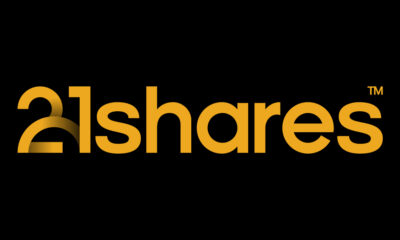
 Nyheter4 veckor sedan
Nyheter4 veckor sedanCrypto Market Risks & Opportunities: Insights on Bybit Hack, Bitcoin, and Institutional Adoption
-
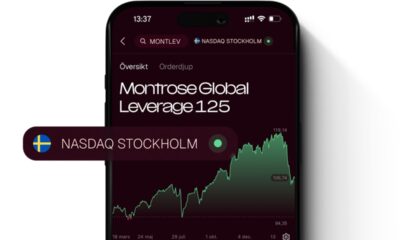
 Nyheter4 veckor sedan
Nyheter4 veckor sedanMontrose storsatsning på ETFer fortsätter – lanserar Sveriges första globala ETF med hävstång
-

 Nyheter4 veckor sedan
Nyheter4 veckor sedanSvenskarna har en ny favorit-ETF
-
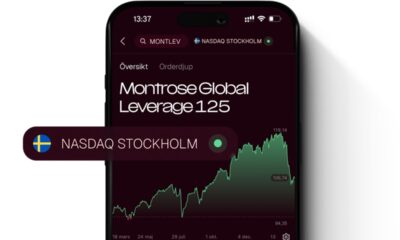
 Nyheter4 veckor sedan
Nyheter4 veckor sedanMONTLEV, Sveriges första globala ETF med hävstång
-

 Nyheter3 veckor sedan
Nyheter3 veckor sedanSju börshandlade fonder som investerar i försvarssektorn
-

 Nyheter3 veckor sedan
Nyheter3 veckor sedanVärldens första europeiska försvars-ETF från ett europeiskt ETF-företag lanseras på Xetra och Euronext Paris
-

 Nyheter4 veckor sedan
Nyheter4 veckor sedanEuropeisk försvarsutgiftsboom: Viktiga investeringsmöjligheter mitt i globala förändringar
-

 Nyheter3 veckor sedan
Nyheter3 veckor sedan21Shares bildar exklusivt partnerskap med House of Doge för att lansera Dogecoin ETP i Europa




